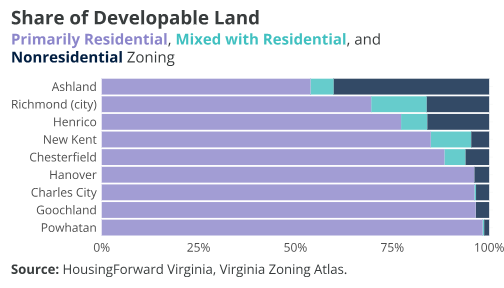The Newest Region of the Virginia Zoning Atlas is here
Most people spend their summers taking it easy— going to the beach, a road trip, or even a nice staycation. Instead, we spent our summer deep in the zoning ordinances of the Richmond region. A dream vacation for a superstar zoning administrator or an urban planning zealot? Maybe. But for us, it means seeing another planning district region added to the Virginia Zoning Atlas! We analyzed over 200 zoning districts and overlays. This amounted to over 3,000 zoning ordinance pages.
Comprising just nine jurisdictions, the region represented by PlanRVA is different from previous regions. While both Hampton Roads and Northern Virginia had multiple independent cities and incorporated towns, the Richmond region is home to just one city, Richmond, and one town, Ashland. (Petersburg/Tri-Cities folks, worry not, we haven’t forgotten about you— you’re just part of a different planning district.) But does that make a difference to how the region zones for housing?
Let’s take a peek at some of the initial findings.
The Richmond region is still strictly separating land uses.
Greater Richmond has more in common with Hampton Roads in terms of zoning districts and their relationship to residential uses. Ninety-one percent of the region is dedicated to primarily residential zoning districts— meaning that housing makes up the majority, if not all, uses in that district. Meanwhile only 3% of the region is zoned for mixed-use, allowing for the co-location of residential, commercial, and other uses.
The City of Richmond has the largest share of land dedicated to mixed-use zoning (14%), followed by New Kent County (yes, New Kent!) at 10%. The region’s core suburbs — Chesterfield and Henrico counties — each come in at roughly 5% and 7%, respectively.

As the region continues to grow, the use of more smart growth development strategies can ensure that that growth is sustainable. More transit-oriented development that allows for housing, jobs, and retail activities in a single location can reduce traffic impacts, increase access, and preserve greenspace. The expansion of bus rapid transit (BRT) into Henrico County could be transformative for housing in the county.
Land for multifamily housing is in short supply.
How about the share of land localities have zoned for multifamily housing? As of today, that’s just 16% of all developable land across the Richmond region. In other words, for every acre where apartments could be built, there are another 4+ acres where they are effectively banned.
That’s a bleak statistic for housing advocates, but it gets even worse. The majority of zoning districts that “allow” apartments require a public hearing process that opens the door for NIMBYs to grind it all to a halt. The actual portion of the region’s land where apartments are allowed by-right is a paltry 2%.
Rental housing is in high demand across the Commonwealth as debt and interest rates continue to keep many households on the homebuying sidelines. And while the region has seen a multifamily housing boom in the past few years, forcing most of this housing through a public hearing process ultimately increases rents, delays construction, or outright stops shovels from ever touching the ground.

The City of Richmond (19%) and Henrico County (9%) lead the region in the amount of land allowing for by-right multifamily housing. Chesterfield County, the region’s largest jurisdiction and also one of the fastest growing in the state, dedicates just a single percent of its developable land to by-right multifamily housing. These figures present a stark difference in approach to housing even among comparable jurisdictions like Henrico and Chesterfield.
This is just a preview of our findings. Tonight at 6pm, we’ll tell the rest of the story at the University of Richmond’s Queally Center during Reading Between the Lines. If you can’t join us, make sure you’re subscribed to emails so we can send our full report to your inbox in the coming days.